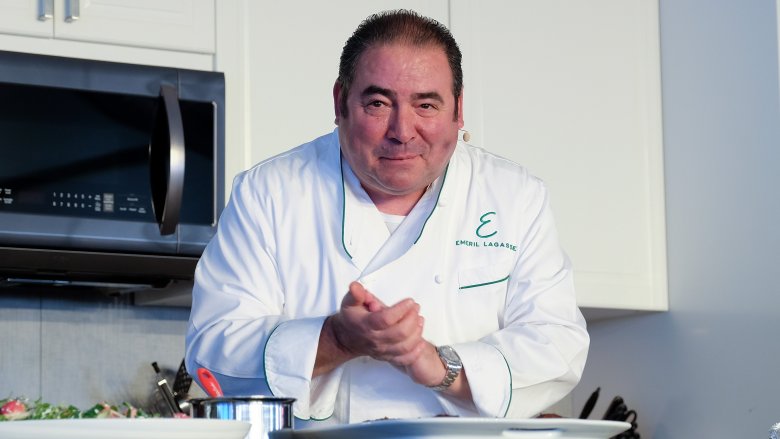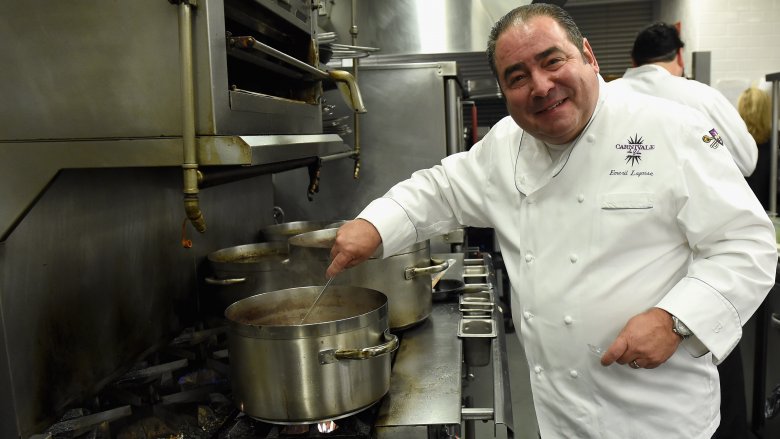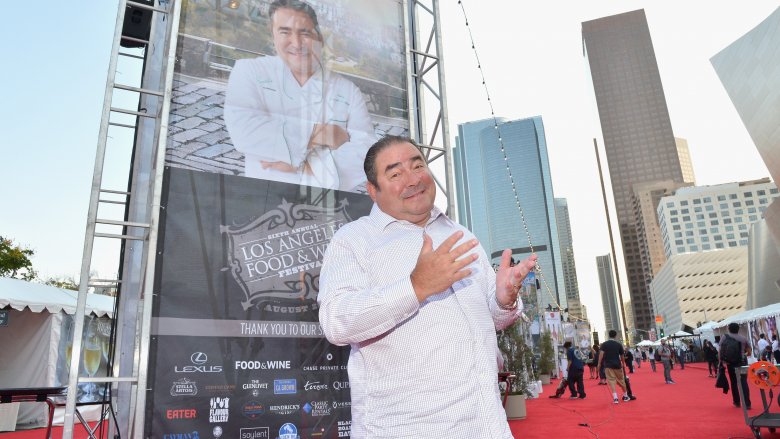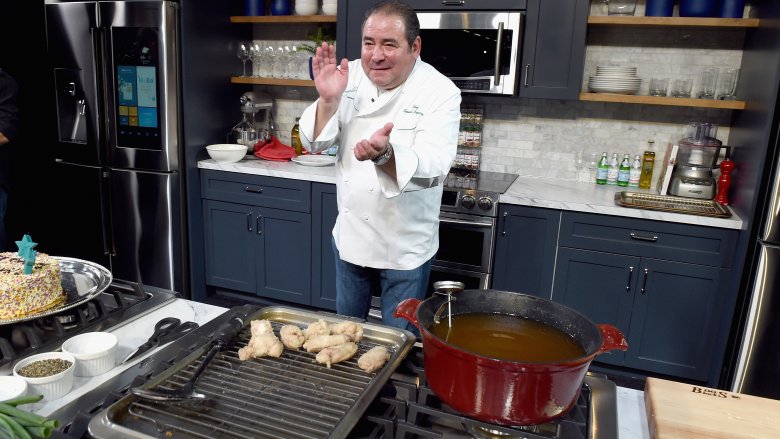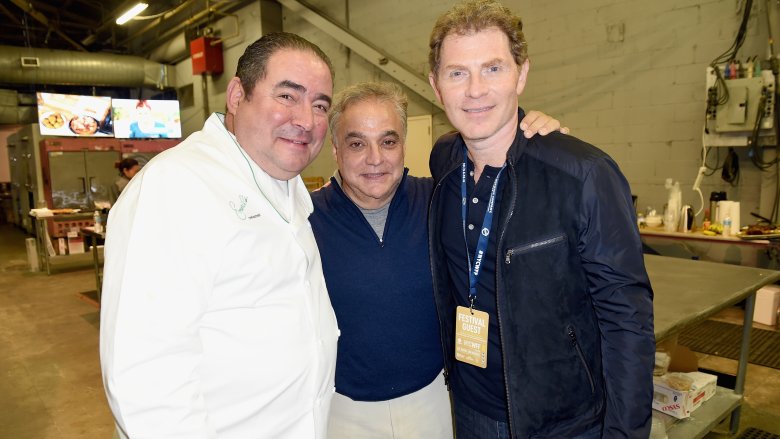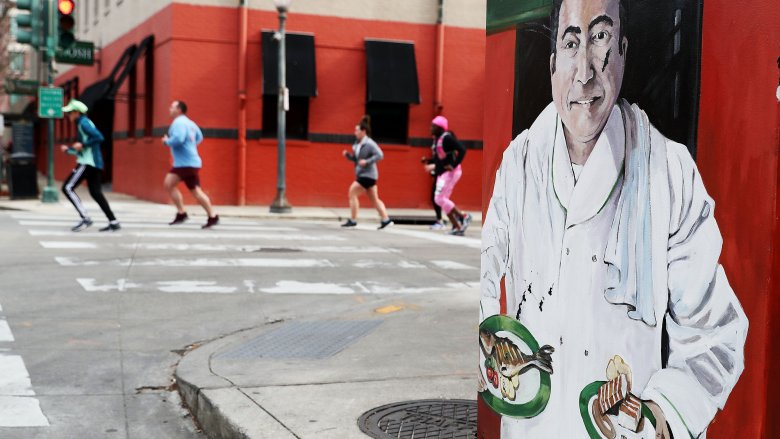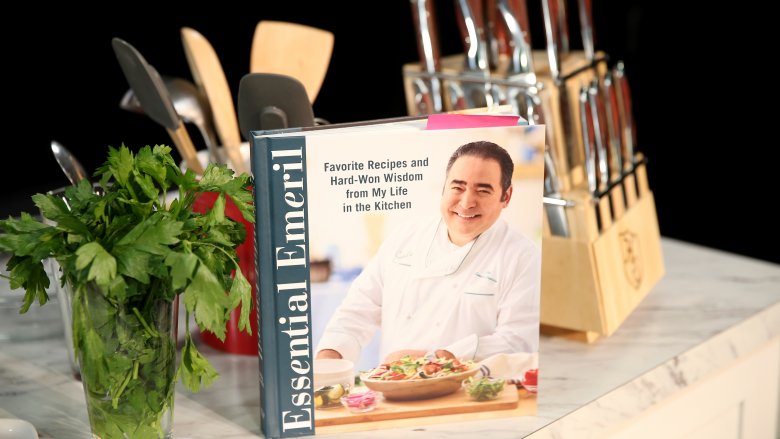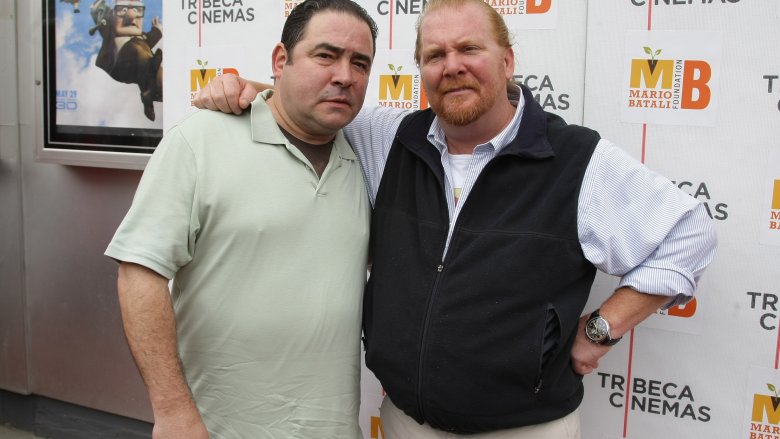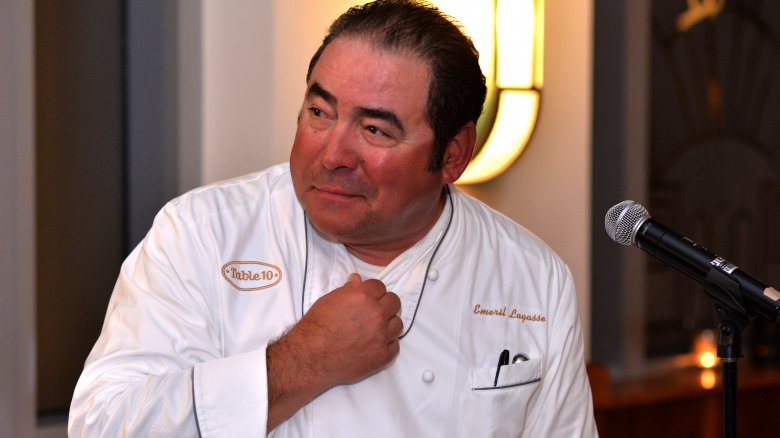Why Emeril Lagasse's Food Network Show Was Canceled
Bam! It's impossible to describe just how influential Emeril Lagasse was in shaping today's culinary landscape. He was the first celebrity chef that many of us knew, and he was the one that got countless people not just in the kitchen and cooking, but believing that they could cook. And that's a huge deal.
Emeril Live laid the groundwork for today's cooking and travel shows, launched a major product line, and sparked a nationwide interest in cooking. But in 2007, Food Network announced that they had taped the last episodes in the series and were putting an end to the show that got so many people into the kitchen — and helped launch the network. The announcement came after Emeril had been on the air for an impressive decade, and it also came at a time when Lagasse was still under contract with the network. Sounds complicated, right? It is.
So, why did Emeril Live really get the ax?
The official line
When Food Network announced the end of Emeril Live, they also went public with their reasons. According to the official line, it was simply time to say goodbye.
Network publicist Carrie Welch had this to say (via Today): "The only reason would be that it hit a ton of television milestones and, you know, all good things come to an end."
And that absolutely doesn't sound like the whole story, does it? That's because it's not. Lagasse himself issued a statement (also through Welch) that sang the praises of his dedicated staffers and of the viewers who had made his show popular for so long, but he, too, was mum on what was going on behind the scenes.
Food Network president (at the time) Brooke Johnson gave a similarly vague statement to The New York Times, saying that while they still valued Lagasse as an integral part of their team, "All good things come to an end, and it was time to do something new."
From top priority to cancellation
The end of Emeril Live was a huge deal. The Food Network is huge today, and it's easy to forget that way back in the olden days of the 1990s, it was struggling to even stay afloat. Allen Salkin's book From Scratch: Inside the Food Network (via NPR) gives us a pretty unblinking look at just how far they've come — largely thanks to Emeril Live, which was launched in 1997.
In the early days, it wasn't so much the Food Network as it was the Emeril Network. He held the nightly 8 p.m. time slot, and at a time when the young network was barely squeaking by, it was Lagasse they flaunted to prove that they had the chops to make it. Salkin describes him as their "million-dollar man in chef's whites," the star they pointed to when they wanted to impress.
His contract in those early days was a three-year deal, for which he was paid $333,334 each year. That doesn't sound like much at all, especially today, but Food Network lauded it as a million-dollar deal. The network was built on his shoulders, and now — at a time of flashy competition shows and global features — it's easy to forget just how important his pretty straightforward, very standard sort of cooking show was... and that brings us to a big problem.
There was a major problem with the show
Brooke Johnson took over as president of Food Network in 2004, and according to Allen Salkin's book From Scratch: Inside the Food Network (via NPR), Lagasse was pretty much untouchable. He had a say in everything that went on at the network, right down to picking the new talent and pushing for (or vetoing) the appointment of executives. But when Johnson called in outside consultants to try to find out just what it was that would make the network grow, they found there was a problem stemming from shows like Lagasse's.
The team found most TV viewers thought Food Network was pretty boring, and showed an almost endless slew of what they described as "dump and stir" demonstrations. Sounds familiar, doesn't it?
That problem was made even worse by the sudden competition from other networks like TLC and the Travel Channel, who were making food much, much more interesting. They were attracting a huge part of the market by shooting on the road instead of in a studio, and when consultants put together a graph showing just how their viewership was going elsewhere, they called it "Nibbled to Death." Simply put, Emeril Live was just dull in comparison to what else was out there, and their survey said he was dragging the network down.
There was a shocking slump
There was a lot going on at Food Network at the same time they were looking to put Emeril Live on the chopping block. According to The New York Times, the network's parent company, EW Scripps, had plans to split the network into two parts: Food Network and HGTV. But along with the announcement of the planned split came shares that plummeted to a new low, and the same was happening to their ratings.
At the same time network execs were boasting about their average prime-time viewership of 778,000, they weren't talking about their flagging daily ratings. Those were down to 544,000 from the previous year's 580,000 — not the way a network wants to see their numbers change. They were also looking at dismal weekend numbers, with viewership down by about 15 percent. The numbers loss was significant: the network was suddenly left owing refunds to advertisers who weren't reaching the viewership they'd signed on for.
We all know slumping numbers is a very real indication that something at a network needs to change, and that meant rethinking just what kind of programming they were putting on. Emeril Live became yesterday's news, while contemporary viewers wanted more.
He just got too big
Emeril Live was one of the network's flagship shows, and Lagasse was one of their biggest stars. But he also came with the price tag his star power demanded, and for a still-fledgling network, that meant choices needed to be made.
According to to Allen Salkin's book From Scratch: Inside the Food Network (via NPR), it was costing the network "hundreds of thousands of dollars a week" to keep Emeril Live on-air. They may have been bragging about how much they paid the chef, but those big paychecks were hitting them where it hurt.
That's a lot on its own, but compare that to some of the shows of up-and-coming new stars like Bobby Flay and Rachael Ray. Each episode of their shows cost an average of $40,000 at the time, and that included their salary. In other words, for about the same amount of money, the network could either support a week of Emeril Live or get an entire, 13-episode season of a show featuring some of the industry's up-and-coming young talent that would give viewers more of what they were looking for. It's a decision that doesn't take a business degree to make.
They tried to overhaul it first, but it backfired
In spite of all the things that were stacked against Emeril Live, the network didn't give up easily on the show or their star chef.
After outside consultants discovered that viewers were turning away from Emeril Live (and, by extension, the network) because of the perceived dryness of the show, Food Network insider Allen Salkin says (via NPR) that they first spent hundreds of thousands of dollars overhauling Emeril Live's set and updating it to give the show a trendier look. They got rid of his monologue, gave him new equipment, and tried to get him to play to his strengths: high-energy cooking in the kitchen.
They also started to branch out away from the formula that had been so popular for so long, inviting musical acts on the show, and having Lagasse share his stage with younger chefs in an attempt to bring back the viewers. There was a somewhat unforeseen side effect, though: some of those new chefs — like Sunny Anderson — were given their own shows that threw the contrast between new and old into even starker light.
He's not into reality TV
Reality television is everywhere today, but it wasn't long ago that it was something of a dirty word in the TV business. At the time Emeril Live was looking toward the light at the end of the tunnel, cable TV was just starting to head that way. Food Network execs tried to convince him of that.
Susie Fogelson was the head of marketing, and she was also the one that reached out to Emeril's agent to try to convince him to get the chef on another up-and-coming show she hoped would help raise his profile, expose him to new viewers, and lure those viewers back to Emeril Live. Network insider Allen Salkin described it (via NPR) as "a last-ditch effort to keep Emeril secure," but Lagasse's agent balked big-time. The show? Iron Chef. The agent counter-offered: instead, he would be open to having family-friendly guests — like Sesame Street's Elmo — on Emeril Live. Food Network was less-than-thrilled.
When Lagasse spoke with GQ in 2016, he made it quite clear that he thought it just wasn't his kind of thing.
"They wanted me to create these reality shows for Food Network, and at the time I just wasn't into it," he explained. "I'm old-fashioned, and I want to teach people how to cook, how to eat, how to serve, how to shop, how to drink wine, how to mix a cocktail properly. I didn't necessarily at the time want to get into this competition stuff."
They weren't cashing in on the merchandise
For most celebrity chefs, it's not just about the ratings and how many viewers they bring. It's also about the merchandising, and Lagasse — like many Food Network stars today — had a full range of everything from cookbooks and cookware, to salad dressings and spices. But when he negotiated his contract with Food Network, they hadn't accounted for the money he was going to make selling his branded goods.
Starting in around 2006, The New York Times says Food Network policy began shifting a bit. They wanted more control over the licensing agreements their stars made, and when they started signing newcomers like Bobby Flay and Rachael Ray, they worked it into their contracts that chef-branded product lines would be as much about the network as they were about the chef.
Lagasse's contract had no such rider, and Food Network wasn't making any money off his outside ventures and had no control over what he did. And at a time when the network "changed in its own mind from a television network to a brand," there just wasn't room for Lagasse to get special treatment.
He wasn't the only one left out
Emeril Live wasn't the only casualty of that particular point in Food Network history, says The New York Times. At a time when they were competing with shows like Kitchen Nightmares and Top Chef, and personalities like Mojo's Chef Daniel Boulud and Travel Channel's Anthony Bourdain, it was definitely a time of out-with-the-old, in-with-the-new.
Mario Batali's Molto Mario had been cancelled in 2004, and Food Network had passed on a new series he had pitched not long after. The appearance of other types of shows — like Robert Irvine's Dinner: Impossible and Ace of Cakes — led Batali to issue some strong words toward the network and the direction he saw them taking.
"They don't need me. They have decided they are mass market and they are going after the Walmart crowd. [It's] a smart business decision. So they don't need someone who uses polysyllabic words from other languages."
It was clear that Food Network was moving on ahead, and chefs needed to change with them. Those that didn't were left behind.
It was just time for a break
It's been more than a decade since the cancellation of Emeril Live, and Lagasse has gone on to do other shows. What does he think now, with the benefit of hindsight?
Lagasse told GQ that Emeril Live had actually convinced him not to retire from television. After The Essence of Emeril, he had considered getting out of show business and just concentrating on his restaurants... until he hit on the late-night talk-show sort of format that inspired Emeril Live. And as far as the end of that was concerned, he had this to say:
"When it ended, everybody felt like it was time for a little break. I didn't necessarily think that, but that's what everybody else thought, that maybe it was time for a break from Emeril. And... you know. So I went and did some other things..."
And that's essentially what the official line on Emeril Live's cancellation was, but it's also clear that even years later, Lagasse still isn't convinced it was the right move. And it had to be hard: don't forget, Lagasse was one of the original 10 employees hired at the Food Network.
There's no denying that Emeril Live helped make Food Network into the juggernaut of programming it is today, but does Lagasse think they helped him in any way? Not according to what he told Eater, saying: "The Food Network is not why I have 12 restaurants.... It all started at Emeril's on Tchoup."
